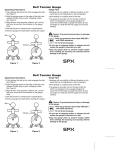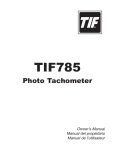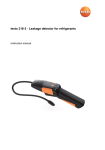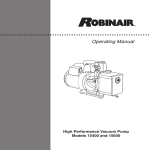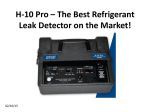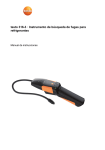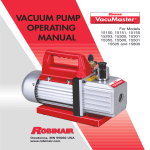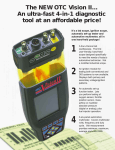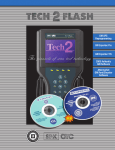Download User Manual - English
Transcript
No. IR-1 Infrared Refrigerant Leak Detector Operator’s Manual Manual del operador Manuel de l’opérateur Product Description The TIF No. IR-1 uses infrared optics to create a refrigerant leak detector that combines sensitivity, speed, battery life, portability, and ease of use. This unit detects leaks as small as 0.15 oz/year, and meets both SAE J1627 and J2791 standards. The IR-1 comes with a wall charger and a car charger for its compact lithium-ion battery—which can power the leak detector for up to eight hours of continuous operation before needing to recharge. A choice of three sensitivity settings keep false alarms to a minimum while allowing detection of even the smallest leak in a refrigerant contaminated environment. A 30-second, selfcalibration test occurs whenever the unit is powered on to ensure optimal performance. A built-in replaceable filter blocks moisture and particulates, preventing damage to the sensor. Specifications Sensing element: enhanced infrared photo optics Refrigerants: HFC, CFC, HCFC, and blends Sensitivity level (per SAE J2791): HIGH: 0.15 oz/year and higher MED: 0.25 oz/year and higher LOW: 0.5 oz/year and higher Response time: less than one second Battery life: up to 8 hours continuous use before recharge Auto off: 10 minutes of inactivity Battery: 3.7V, 1800 mAH rechargeable, lithium-ion (No. TIFIR-9) Low battery LED: illuminates when 1 hour of battery life remains Charge time: less than 4 hours @ 300 mA Operating environment: 32ºF (0°C) to 122ºF (50°C) at <75% RH Storage environment: <80% RH for detector and battery For 80% battery recovery: -4ºF (-20°C) to 140ºF (60°C) less than 1 month -4ºF (-20°C) to 113ºF (45°C) less than 3 months -4ºF (-20°C) to 68ºF (20°C) less than 1 year Accessories included: wall charger, car charger, storage case, battery (installed), and operator’s manual. Safety Precautions Warning: To prevent personal injury and/or equipment damage, l Read, understand, and follow all warnings stated in the Lithium Battery Care section of this manual. l DO NOT charge the battery with any charger other than the chargers supplied with the unit. l DO NOT use the IR-1 without a clean filter correctly installed in the tip. l DO NOT draw moisture in through the probe. Lithium Battery Care The IR-1 operates on a lithium-ion type NP-120 battery. For long battery life and safe operation, observe all warnings. Warning: To prevent personal injury and/or equipment damage, Do not disassemble or attempt to repair the battery or protective circuit. l Never attempt to charge the battery if it has been removed from the unit. l Do not expose the battery to temperatures above 140°F (60°C). l Do not charge the battery near a fire or in a hot vehicle or direct sunlight. l Do not solder directly on the battery. l Do not subject the battery to impact. l Do not expose the battery to moisture or immerse it in fluid. l Do not deform, pierce, or damage the battery. l Do not touch a battery that is leaking electrolytes. If battery fluid should get in your eyes, flush with fresh water, do not rub eyes, and see a physician immediately. l Do not use a battery if it is deformed, smells bad, changes color, or appears abnormal. Send the unit in for a replacement battery immediately. l Charging the Lithium Battery Two types of chargers are supplied with the IR-1 leak detector. The AC charger plugs into a wall outlet (100-240 VAC, 50/60 Hz); the car charger plugs into a vehicle cigarette lighter DC plug. 1. Before using the unit the first time: Fully charge the battery. The unit was packaged and shipped from the factory with the battery only partially charged. 2. When the battery is low: The LOW-BATT LED will illuminate in red. Plug one end of the charger into the top of the unit, and the other end of the charger into the power source. The LOW-BATT LED will blink while charging until the battery is fully charged. 3. To recharge the IR-1: NOTE: Charge within the charging environment specifications of 32°F (0°C) to 122°F (50°C) at <75% RH. 4. avoid discharging the battery completely. Recharging a partially discharged battery more frequently is better for the life of a lithium-ion battery. Functions and Settings ON/OFF Protection Press and hold the ON/OFF button for one second to turn the IR-1 ON or OFF. This one-second delay protects against accidental ON or OFF. LED Bar Graph Display The eight-segment LED display indicates the degree of change in refrigerant concentration. As the concentration of refrigerant in the air increases, the number of illuminated bars on the display increases also. L/M/H Button (Sensitivity Levels) Set the unit’s sensitivity level by pressing the L/M/H button. Low (L), medium (M), or high (H) sensitivity level is indicated by its respective LED. The higher the background concentration of refrigerant in the air, the lower the sensitivity level should be set. To detect a very small leak in a high refrigerant background, use the Contaminate Mode. Mute Button Press the MUTE button to toggle the audio portion of the IR-1 on or off. Peak Button The PEAK function stores the highest change in refrigerant concentration achieved while continuing to detect leaks. Press the PEAK button to toggle this function on and off. The PEAK LED illuminates when this function is turned on. Turning the PEAK function off clears the peak information. Contaminate Mode To detect even the smallest leak in refrigerant-contaminated environments, press the PEAK button rapidly four times. The green LED will flash rapidly to show contamination mode is on. Press the PEAK button rapidly four times again to turn contamination mode off. Leak Detection Procedure 1. Press and hold the ON/OFF button for one second. The warmup and calibration sequence takes approximately 30 seconds. The sensitivity level defaults to High at startup. 2. The most likely place for a refrigerant leak is at soldered joints in refrigerant lines and changes in cross section or direction of these lines. The IR-1 detects changes in concentration of refrigerant, not the absolute concentration of refrigerant. This allows the detection of leaks in locations that may have refrigerant in the air. Use the following “double pass” method to find leaks from the detection of change in refrigerant concentration: A. Hold the IR-1 in one hand and, with your other hand, guide the tip of the wand to within 3/8 in. of the refrigerant lines. B. Move the tip along the refrigerant lines at a rate of no greater than three inches per second. C. When the IR-1 indicates a change in concentration, note that spot on the line, but keep the tip moving past the potential leak to refresh the air space within the IR-1 with clean air. D. Move the tip back to, and past, the first leak spot noted. When the IR-1 indicates a second change, note that spot on the line. The leak will be near the midpoint of the two noted change spots. NOTE: If the tip is held at a detected leak for more than five seconds, the IR-1 will not detect a change. E. The IR-1 is sensitive and can take up to 30 seconds to clear after detecting a small amount of contaminate. Typically, it will clear in 2 to 15 seconds. SAE J2791 False-Trigger Test Results Chemical Detection Windshield washer solvent Ford spot and stain remover Ford rust penetrant and inhibitor Ford gasket and trim adhesive Permatex Natural Blue cleaner and degreaser Ford brake parts cleaner Ford clear silicone rubber Motorcraft G-05 antifreeze / coolant Gunk Liquid Wrench Ford pumice / lotion hand cleaner Ford Motorcraft DOT-3 brake fluid Ford spray carburetor tune-up cleaner Ford silicone lubricant Dexron automatic transmission fluid Mineral engine oil Yes No Yes Yes No Yes No No No No No Yes No No No Time to Clear (seconds) 6 5 6 6 5 - Accessories and Replacement Parts Optional Accessories Order No. Extension Probe (9 inch).......... TIFIR-4 Rigid Extension Probe.............. TIFIR-5 Replacement Parts Order No. 100-240 VAC Charger.............. TIFIR-6 12 VDC Charger....................... TIFIR-7 Filters (5) and O-rings (3)......... TIFIR-8 Lithium-ion Battery................... TIFIR-9 Filter Replacement A filter, located in the tip of the wand, blocks moisture and other contaminants from the sensor. When this filter becomes wet, it restricts the flow of air and must be replaced. To replace the filter: 1. Unscrew and remove the tip of the sensor to expose the white filter. 2.Remove and discard the filter. 3.Position a new filter in the tip so the round end of the filter is closest to the tip of the wand. NOTE:Use only TIF supplied replacement filters. Storage The battery should have a 40%-50% charge during prolonged storage of a month or longer. The correct storage environment is critical to battery life. Storage environment: <80% RH for detector and battery. For 80% battery recovery: -4ºF (-20°C) to 140ºF (60°C) less than 1 month -4ºF (-20°C) to 113ºF (45°C) less than 3 months -4ºF (-20°C) to 68ºF (20°C) less than 1 year NOTE:Battery life will be reduced significantly if the battery is stored with a full charge and/or at high temperatures. Warranty This product has been produced to provide unlimited service. Should it become inoperable after the user has performed the recommended maintenance, a no-charge repair or replacement will be made to the original purchaser. This applies to all repairable units that have not been damaged or tampered with. The claim must be made within ONE YEAR of the date of purchase. Garantía Este producto se produjo para proporcionar servicio ilimitado. Si llegara a dejar de funcionar después de que el usuario ha llevado a cabo el mantenimiento adecuado, se hará un cambio o reparación sin cargo al comprador original. Esto aplica a todas las unidades reparables que no se han dañado ni alterado. El reclamo debe realizarse en el período de UN AÑO a partir de la fecha de la compra. Garantie Ce produit a été conçu pour offrir un service illimité. Si celui-ci devenait inopérant après que l’utilisateur aie effectué l’entretien recommandé, une réparation ou un remplacement sans frais sera fait au bénéfice de l’acheteur original. Ceci s’applique à toutes les unités réparables qui n’ont pas été endommagées ou trafiquées. La réclamation doit être effectuée en dedans d’UNE ANNÉE de la date de l’achat. 655 Eisenhower Drive Owatonna, MN 55060-0995 USA Toll Free: 1-800-327-5060 Fax: 1-866-287-7222 Web site: www.TIF.com Form No. 549962 March 10, 2011 Rev. C © 2008 SPX











